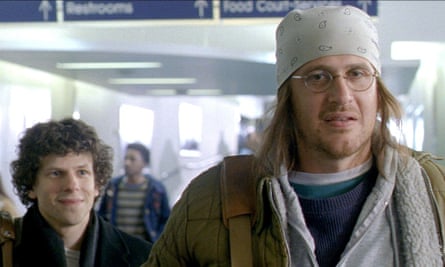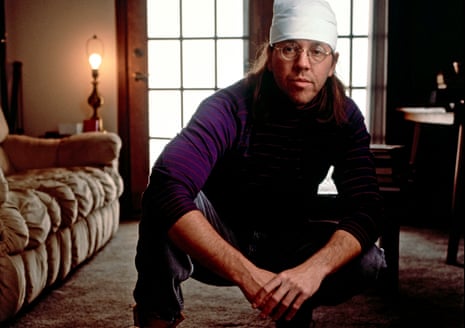Recently, the impersonal fecundity of Google Alerts spat into my email inbox the news that a new oil painting of David Foster Wallace was for sale. The painter wanted $1,200 for his work. He lived in, of all places, Pistoia, Italy. The portrait is taken from a familiar photograph. DFW has on his granny glasses, a loose black shirt, and his long scraggly hair is held back by that broad white bandana that always reminds me of a battlefield bandage. The painting’s background is tundral and the Arctic-y light in turn gives Wallace’s face a pure cast it didn’t possess in real life. The sceptical, irritated gaze he has in the original photograph – he looks like the photographer has just asked him the dumbest possible question – has been replaced by a milder one, and his elongated features increase the resemblance to Jesus.
What a remarkable voyage Wallace has been on since his dreadful suicide in 2008. He has somehow moved from being the author of a massive novel that survived thanks to a cult of young intense readers into an essential guide to our cultural predicament. These days, especially given the new film The End of the Tour, the record of a road trip he took with a magazine journalist, I’m sure fewer people know DFW as a writer than as a public figure, and that figure is a sort of laical saint, a professor of gentle, sustaining wisdom to whom we can turn in moments of confusion.
The movie willy-nilly will increase that identification. It’s remarkably modest compared to most literary biopics or indeed most movies about artists. No moments here of wild inspiration, where the author leaps out of bed, hair askew, and must, must write. Instead Wallace (Jason Segel) and his designated recorder (Jesse Eisenberg) meet in his house in the bland American midwest, they drive and talk, they eat (unhealthy foods) and talk, they meet some of Wallace’s friends who are mistrustful of his plus-one and talk, even fight a bit. At one point there’s an author reading. They part, Lipsky having forgotten a shoe. Even were Wallace not generally wise in his exchanges in the movie, two hours with DFW as your intimate on screen will only increase the tricky sense that he is our friend, someone we know. How can it not? No denying this quasi-friendship can be an important tool to have in our psychic toolbox, but I can’t help wondering whether the conversion of DFW into our intimate also costs us something valuable. It’s not just that we risk turning him into a paradigm of virtue he himself would probably have laughed at. It’s more crucially that the capture of DFW by the smart side of the self-help movement may be hurting our ability to read the treacherous, more darkly complicated, brilliant writer he really was.

The End of the Tour is based on David Lipsky’s book that records the week he spent with Wallace in 1996 while he was publicising Infinite Jest, when DFW’s fame was at its previous apogee. But in the seven years since his death, I’ve ceased to be surprised by any eruption of interest in him. There are the T-shirts and the tattoos; there has been This Is Water, a book made from DFW’s address to the graduates of Kenyon College in 2005 urging them to live a centred and aware life, which in turn led to a hammy dramatisation that got over four million views on the internet before his estate ordered it taken down – though, of course, in the modern era nothing is ever truly gone. It has popped back up on YouTube. If you’re curious to see it, “it’s all just a Google search away. Knock yourself out”, as DFW once wrote. There have been two conferences on Wallace at one of the universities where he taught, Illinois State, which seemed as much a place for devotees as academics. (Not that there’s anything wrong with devotees – it was the devotees who kept his reputation alive during the lean times.) Perhaps here I should also add my own biography of Wallace, which has the form’s obligatory contradiction, trying to send you toward a writer’s work in part by interesting you in the person who wrote it.
One way or another, DFW now sits securely at the centre of culture. To know about him is a badge of awareness. It would be easy to dismiss this sort of renown as trivial. People have always wanted to seem smart by admiring what people they think are smart admire (Mindy Kaling has just announced she needs to read more DFW). But I think this misses the point. Wallace is not famous for being famous; he’s famous for being moral. A great many of those who care about him have had struggles of their own – whether depression or addiction or just a sense that the world is spinning more and more insanely away from the bearable. The novelist Garth Risk Hallberg put it best when he noted at the time of Wallace’s death that he was the embodiment of a generation’s anxiety: “Polymathic, ironic, brilliant, damaged, and under intense pressure to perform.” This identification is also, to me, what makes the adoration of DFW different from that directed at say, Sylvia Plath, John Berryman or Virginia Woolf. The people who mourn him don’t just miss the work he never lived to produce; they miss him as a being on this planet. His death impinged on the chances for their own happiness. This aspect of DFW’s renown is underscored in The End of the Tour as well. In a pivotal moment, Wallace lectures Lipsky: “Just be a good guy.”
Relentlessly self-critical, Wallace would never himself have thought of his role as that of a seer; he was not by nature a lecturer. What is essential in Wallace is not the goodness, anyway, but the struggle to get to that goodness. What made me want to write his biography was my curiosity about what it felt like to dwell in his twangy, inbetween psychic state, full of intense ambition and equally stubborn flaws.
But really the canonisation of St Dave is not my main issue. There are worse things than to simplify or purify the life of a well-known person in search of our own wisdom, comfort, security. I have more than once used DFW in this way myself during an uncomfortable night of the soul. The more problematic part for me is where all the hero worship leaves his books and us as readers for them. Wallace’s books and the public perception of his personality have seemed for some time headed in opposite directions: one reaching for a spiritual purity, the other deeply enmeshed in the problematic and human. This is only partly true when considering Infinite Jest, which is generally reputed to be the hardest of his works because it is his longest, at 1,079 pages. But for the new kind of DFW loyalist, it is paradoxically the easiest of his writings to read, because the story demonstrates faith both in humanity and in writing. In it, a reformed addict named Don Gately finds the inner strength to survive physical trauma without retreating to addiction. (A friend of Wallace’s described it to me as “pretty much a valentine to Alcoholics Anonymous”.)
You can read Infinite Jest in many ways but that’s not to me the most vibrant. The more intriguing side belongs to the other characters in this panoramic story, some of them young athletes at a nearby tennis academy, children of privilege and confusion, who are trying to find their way through the muck of modern experience to some sort of goodness and don’t solve their spiritual problems as ably as Gately. Arguably, it is their desultory, questing narrative that Wallace continues in his later books, rather than the redemptive one. How else to explain the endless interrogations in Brief Interviews with Hideous Men, his next work of fiction and one of the most exquisite portraits of inauthenticity in literature? Or the disparate and sometimes deliberately unlovable stories in Oblivion, the successor volume? Or Pale King, his posthumous novel, with its morose, isolated characters trying to carve meaning out of stasis and boredom?
There’s a sheet of paper in the University of Texas archives, where DFW’s papers are housed, in which the author wrote in his tiny anxious handwriting, just a few months after his novel was published. “I’m back to thinking IJ was a fluke. I feel nothing lapidary inside.” The usual understanding of what came next is that Wallace, overwhelmed by the admiration Infinite Jest had received, was nearly paralysed by the fear he could not write as good a book again. In his correspondence and his interviews you can find a lot of indications that this is true. But I wonder if over the years he might not, at least in part, have also grown less interested in writing anything else like Infinite Jest. Did he accept at some point that he was stuck with what Zadie Smith, in a long essay about Brief Interviews, called his “difficult gifts”, his odd, gritty, stubbornly complex and ill-feeling view of human interactions – and that this on the whole might be as valuable as being a good guy?

Comments (…)
Sign in or create your Guardian account to join the discussion